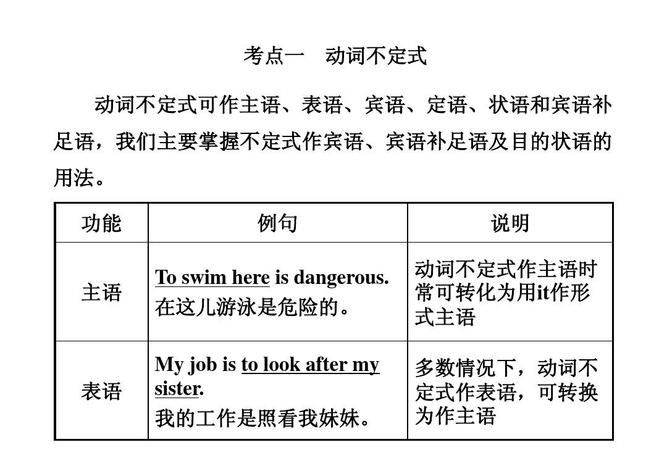本文目录
新概念英语非谓语动词之不定式语法讲解视频
新概念英语非谓语动词之不定式语法讲解
1.定义:具有名词、形容词及副词性质并具有时态、语态变化。

2.形式:(以do为例)
主动语态 被动语态
一般时 to do to be done
进行时 to be doing
完成时 to have done to have been done
完成进行时 to have been doing
3.用法:
(1)用作主语:
To speak good English is not easy.
or: It is not easy to speak good English.
(采用形式主语 it 以避免头重脚轻)
It took me an hour to do the work.
(2)用作宾语:
She decided to take the examination.
I hope to meet him soon.
(3)宾语补足语:
They expected us to help them.
He wants his son to study hard.
金牌重点:
不定式作宾补,如谓语动词是感官动词,使役性动词(see, hear, notice, watch, make, have, let...),则不定式符号“to”须省略,但在被动语态中不能省。
I heard them sing in the classroom.
I made her clean the room.
The girl is heard to sing an English song.
(4)用作表语:
To teach is to learn.
His job is to sell cars.
(5)用作状语,表示目的',结果:
We come to school to study English.(目的)
= in order to
I hurried to the store, only to find it closed.(结果)
(6)定语:不定式短语作定语须位于名词之后。
He asked for a piece of paper to write it on.
= to write it on the piece of paper.
The poor man has no house to live in.
= to live in the house.
Have you anything to do?
= to do anything
4.不定式的时态意义:
She seems to dance very well.(现在情况)
She seems to be dancing in the dancing hall.(正在进行)
She seems to have danced well.(过去情况)
Has was happy to have been staying with his uncle.(动作持续一段时间)
5.不定式语态:
The doctor [wrecommend]recommended[/w] him to air the room.
The doctor recommended the room to be aired.
She expects the police to find her bicycle.
She expects her bicycle to be found by the police.
She felt a bit puzzled as he had asked her such a question.
She felt a bit puzzled to have been asked such a question.
6.不定式否定形式:not to do ...
He got up early in order not to miss the train.
测试精编
1. Did you find out ________ the pie out of oven?
A. to take B. have taken C. when to take D. being taken
2. You would be irritated if you watched the mail ________ on your desk every day.
A. putting up B. to be put up C. to pile up D. pile up
3. We shall set Jim ________ the passage.
A. explaining B. explained C. to explain D. explain
4. In fact, she would rather leave for San Francisco ________ in Los Angeles.
A. tostay B. than stay C. than staying D. than have stayed
5. Madame Curies is believed ________ the radium.
A. discovering B. having discovered C. to have discovered D. to discover
(后设答案,大家不要偷看哦~(*^__^*) 嘻嘻……)
KEYS
1. C 2. D 3. C 4. B 5. C
;非谓语动词的用法
导语: 非谓语动词在英语中很常见,关于非谓语动词的语法知识自然就要大家能够熟练掌握。下面是我为您收集整理的非谓语动词的用法,欢迎阅读!
一、非谓语动词的概念
动词的基本用法是作谓语。当句中已经有了谓语动词了,要选或要填的动词就只能用非谓语形式了。
非谓语形式有三种:1、动词不定式:to do 2、动词的ing : doing 3、动词的过去分词:done。其中不定式表示目的和将来;动词的ing表示主动和进行;过去分词表示被动和完成。
二、非谓语动词的时态和语态
一般式:不定式:主动to do ,被动to be done ; ing 形式:主动doing ,被动being done ;过去分词:被动done
完成式:不定式:主动to have done ,被动to have been done;ing 形式:主动having done,被动having been done
进行式: 不定式to be doing
三、非谓语动词的复合结构
不定式的复合结构:for / of sb. to do sth.
动词 ing 形式的复合结构:宾格或所有格+doing (-ing 形式作主语时,用的所有格+doing)
1. 不定式和动名词作主语的区别
(1)动名词作主语时,通常用以表示一件已知的事或经验,不定式短语通常用来表示一件未完成的事或目的。
Driving a car during the rush hour is tiring.在高峰时刻开车令人厌烦。(经验)
(2)不定式做主语,一般用it当形式主语,把作主语的不定式短语后置。
It took me only five minutes to finish the job.
2. 不定式、动名词和分词作表语的区别
(1)不定式作表语
① 不定式作表语一般表示具体动作,特别是表示将来的动作。
What I would suggest is to start work at once.我的建议是立刻开始干。
② 如果主语是不定式(表示条件),表语也要是不定式(表示结果)。
To see is to believe.百闻不如一见。
(2)动名词作表语:动名词作表语,表示抽象的一般性的`行为。
His hobby is collecting stamps.他的爱好是集邮。
(3)分词作表语
分词做表语有两种情况,一种是现在分词做表语,一种是过去分词做表语,这两者区别是考试中经常考到的地方。
puzzling令人费解的--puzzled感到费解的
satisfying令人满意的---satisfied感到满意的
The pupils will get confused if they are made to learn too much.如果要学生学得太多,他们会感到糊涂的。
The argument is very convincing.他的论点很令人信服。
3. 不定式和动名词作宾语的区别
(1)有少数动词只能用动名词作宾语
acknowledge,admit ,dislike, advocate,complete,appreciate ,avoid,enjoy,delay,escape,deny
例如:I appreciate having been given the opportunity to study abroad two years ago.
我很感激两年前给我出国学习的机会。
(2)有些动词后使用动名词和动词不定式作宾语的差别
① forget to do 忘记要去做某事(此事未做),forget doing忘记做过某事(此事已做过或已发生)
② stop to do 停止、中断(某件事),目的是去做另一件事。stop doing 停止正在或经常做的事
③ remember to do 记住去做某事(未做),remember doing记得做过某事(已做)
④ regret to do对要做的事遗憾,regret doing对做过的事遗憾、后悔
⑤ try to do努力、企图做某事,try doing试验、试一试某种办法
⑥ mean to do打算,有意要…,mean doing意味着
4. 不定式和分词作状语的区别
(1)现在分词与过去分词作状语的区别。
① 现在分词作状语时,现在分词的动作就是句子主语的动作,它们之间的关系是主动关系。
Not knowing what to do, he went to his parents for help.
② 过去分词作状语时,过去分词表示的动作是句子主语承受的动作,它们之间的关系是被动关系。
Given more attention, the trees could have grown better.
5. 非谓语动词常考的其它结构
(1)疑问词+不定式结构
疑问词who,what,which,when,where和how后加不定式可构成一种特殊的不定式短语。它在句中可以用作主语、宾语、表语和双重宾语。
When to start has not been decided.何时动身尚未决定。(主语)
I don't know what to do.我不知道该怎么办。(宾语)
The difficulty was how to cross the river.困难在于如何过河。(表语)
I can tell you where to get this book.我可以告诉你哪里可以买到此书。(双重宾语)
(2)不带to的不定式
① 在表示生理感觉的动词后的不定式不带to。
这类词有: feel observe overhear watch listen to perceive notice see look at hear
On seeing the young child fell into the lake,Eric sprang to his feet,and went on the rescue.
② 另一类是某些使役动词,如make, let,have等。
I would have you know that I am ill.我想让你知道我病了。
上述感觉动词与使意动词转换为被动结构时.其后的不定式一般需带to,
The boy was made to go to bed early.
③ 在do nothing/anything/everything but(except)结构中。
例如:Last night I did nothing but watch TV.
但是,如果谓语动词不是“do nothing,anything,everything”,那么but(except)所跟的不定式则仍须带to。
There was nothing for them to do but to remain silent.

非谓语动词不定式在句中做什么成分
在英语中,不作句子谓语,而具有除谓语外其他语法功能的动词,叫做非谓语动词.非谓语动词有动词不定式;动名词;现在分词;过去分词
非谓语动词用法:
(1可以有名词作用(如动词不定式和动名词),在句中做主语,宾语,表语.
(2可以有形容词作用(如动词不定式和分词),在句中做定语,表语或宾语补足语.
(3可以有副词作用(如动词不定式和分词),在句中作状语
(一)动词不定式:(to)+do,否定式:not + (to) do
(1)一般式:不定式的一般式所表示的动作与谓语动词动作同时发生或发生在 谓语动词动作之后
I'm glad to meet you.
(2)进行式:不定式的进行式所表示的动作与谓语动词动作同时发生
He seems to be reading in his room
(3)完成式:不定式的完成式表示的动作发生在谓语动词动作之前
I happened to have seen the film
_2.不定式的句法功能:
(1)作主语:
To finish the work in ten minutes is very hard.
It is very hard to finish the work in ten minutes.
(2)作表语:
Her job is to clean the hall.
(3)作宾语:
常与不定式做宾语连用的动词有:want, hope, wish, offer, fail, plan, learn,
pretend, refuse, manage, help, agree, promise, prefer, 如果不定式(宾语)后面有宾语补足语,则用it作形式宾语,真正的宾语(不定式)后置,放在宾语补足语后面,
Marx found it important to study English well.
(4)作宾语补足语:
在复合宾语中,动词不定式可充当宾语补足语,如下动词常跟这种复合宾语:
want, wish, ask, tell, order, beg, permit, help, advise, persuade, allow, prepare, cause,
force,call on, wait for, invite.
(5)作定语:
动词不定式作定语,放在所修饰的名词或代词后.与所修饰名词有如下关系:
①动宾关系:
I have a meeting to attend.
注意:不定式为不及物动词时,所修饰的名词如果是地点,工具等,应有必要的介词
He found a good house to live in.
②说明所修饰名词的内容:
We have made a plan to finish the work.
③被修饰名词是不定式逻辑主语:
He is the first to get here.
(6)作状语:
①表目的:
He worked day and night to get the money.
②表结果:
He arrived late to find the train gone.
③表原因:
They were very sad to hear the news.
④表程度:
It's too dark for us to see anything.
(二)动名词
1.动名词的形式 否定式:not + 动名词
(1)一般式:
Seeing is believing. 眼见为实.
(2)被动式:
He came to the party without being invited.他未被邀请就来到了晚会.
(3)完成式:
We remembered having seen the film. 我们记得看过这部电影.
(4)完成被动式:
He forgot having been taken to Guangzhou when he was five years old.
他忘记五岁时曾被带到广州去过.
(5)否定式:not + 动名词
I regret not following his advice. 我后悔没听他的劝告.
2.动名词的句法功能:
(1)作主语:
Reading aloud is very helpful.
It's no use quarrelling.
(2)作表语:
In the ant city, the queen's job is laying eggs.
在蚂蚁王国,蚁后的工作是产卵.
(3)作宾语:
They haven't finished building the dam. 他们还没有建好大坝.
We found it no good making fun of others. 我们发现取笑他人不好.
(4)作定语:
Is there a swimming pool in your school 你们学校有游泳池吗
(三)现在分词
现在分词既具有动词的一些特征,又具有形容词和副词的句法功能.
1,现在分词的形式:否定式:not + 现在分词
(1)现在分词的主动语态:现在分词主动语态的一般式表示与谓语动词所表示的动作
同时发生,完成式表示的动作在谓语动词所表示的动作之前发生,常作状语.例如:
They went to the park, singing and talking. 他们边唱边说向公园走去.
(2)现在分词的被动语态:一般式表示与谓语动词同时发生的被动的动作,完成式表示发生在谓语动词之前的被动的动作.
The problem being discussed is very important. 正在被讨论的问题很重要.
2.现在分词的句法功能:
(1)作定语:
The man speaking to the teacher is our monitor's father.
正与老师谈话的那个人是我们班长的父亲.
(2)现在分词作表语:
The film being shown in the cinema is exciting. 正在这家上演的电影很棒.
(3)作宾语补足语
He kept the car waiting at the gate. 他让小汽车在门口等着.
(4)现在分词作状语:
①作时间状语:
(While) Working in the factory, he was an advanced worker.
在工厂工作时,他是一名先进工人.
②作原因状语:
Being a League member, he is always helping others. 由于是共青团员,他经常帮助他人.
③作方式状语
He stayed at home, cleaning and washing. 他呆在家里,又擦又洗.
④作条件状语:
(If) Playing all day, you will waste your valuable time.
要是整天玩,你就会浪费宝贵的时间.
⑤作结果状语:
He dropped the glass, breaking it into pieces. 他把杯子掉了,结果摔得粉碎.
⑥作目的状语:
He went swimming the other day. 几天前他去游泳了.
⑦作让步状语:
Though raining heavily, it cleared up very soon.
虽然雨下得很大,但不久天就晴了.
(四)过去分词
过去分词只有一种形式:规则动词由动词原形加词尾-ed构成.不规则动词的过去分词
没有统一的规则要求,要一一记住.
过去分词的句法功能:
1.过去分词作定语:
Our class went on an organized trip last Monday.
上周一我们班开展了一次有组织的旅行.
2.过去分词作表语:
The window is broken. 窗户破了.
3.过去分词作宾语补足语:
I heard the song sung several times last week.
上周我听见这首歌被唱了
4.过去分词作状语:
Praised by the neighbours, he became the pride of his parents.
受到邻居们的表扬,他成为父母的骄傲.(表示原因)
Once seen, it can never be forgotten.
一旦它被看见,人们就忘不了.(表示时间)
Given more time, I'll be able to do it better.
如果给予更多的时间,我能做得更好.(表示条件)
Though told of the danger, he still risked his life to save the boy.
虽然被告之有危险,他仍然冒生命危险去救那个孩子.(表示让步)

非谓语动词的用法总结表格
非谓语动词主要包括todo、doing和done三种形式,用法分别如下:
1、动词不定式(to do)作定语表示将来,相当于一个以动词不定式为表语的定语从句。
例句:
Manybuildingsinthecityneedrepairing,buttheonethatistoberepairedfirstisthelibrary.
这个城市的许多建筑物需要维修,但是首先要维修的是图书馆。
2、过去分词(done)作定语表示被动(及物)或完成(不及物)。作时相当于一个定语从句(被动),有时侯也表示完成。
3、现在分词(doing)作定语表示主动(及物)或进行(不及物)。作定语时相当于一个定语从句(主动)。
例句:
Driving a car during the rush hour is tiring.
在高峰时刻开车令人厌烦。

扩展资料
非谓语动词的特点:
1、如果是及物动词可以与宾语连用,可以被状语修饰。
2、可以有逻辑主语,有主动与被动形式。
3、非谓语动词否定式一般用not,并且放在非谓语动词之前。
4、非谓语动词可以有形容词作用(如动词不定式和分词),在句中做定语、表语或宾语补足语。
5、非谓语动词在句中不能单独作谓语,它不受主语的人称和数的限制。
参考资料来源:百度百科-非谓语动词
以上就是关于非谓语动词不定式的用法 ,新概念英语非谓语动词之不定式语法讲解视频的全部内容,以及非谓语动词不定式的用法 的相关内容,希望能够帮到您。

